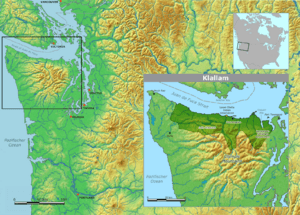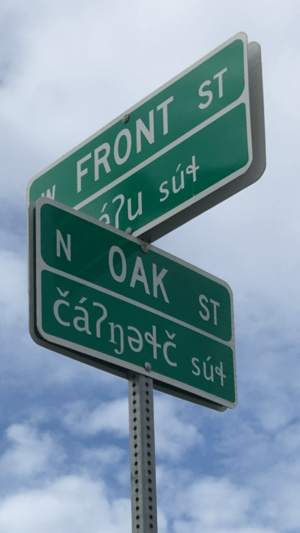Klallam language facts for kids
Quick facts for kids Klallam |
||||
|---|---|---|---|---|
| Nəxʷsƛ̓ay̓əmúcən | ||||
| Native to | United States | |||
| Region | Washington | |||
| Extinct | 2014 (with death of Hazel Sampson)e18 | |||
| Language family |
Salishan
|
|||
| Dialects | Elwha Klallam
Becher Bay Klallam Jamestown Klallam Little Boston Klallam |
|||

Pre-contact distribution of the Klallam people and language
|
||||
|
||||
Klallam (also called Clallam, Ns'Klallam, or S'klallam) is a language that was traditionally spoken by the Klallam people. They lived in areas like Becher Bay on Vancouver Island in British Columbia, Canada. They also lived across the Strait of Juan de Fuca on the north coast of the Olympic Peninsula in Washington, USA.
Klallam is part of the Salishan language family. It is closely related to other languages like Northern Straits Salish dialects, Sooke, Lekwungen, Saanich, Lummi, and Samish. However, speakers of Klallam and these other languages could not always understand each other easily.
The last person who spoke Klallam as their first language passed away in 2014. But today, many people are learning Klallam as a second language. This is helping to bring the language back to life! There were different ways of speaking Klallam, called dialects. These included Elwha Klallam, Becher Bay Klallam, Jamestown S'Klallam, and Little Boston S'Klallam.
Contents
Bringing Klallam Back: Use and Revitalization Efforts
Learning and using the Klallam language is very important to the Klallam people. They are working hard to make sure their language is spoken again.
In 2012, the first Klallam dictionary was published. This book helps people learn the meanings of Klallam words. Port Angeles High School in Port Angeles, Washington, now offers Klallam classes. Students can learn the language to meet their graduation and college requirements. Since 2020, Peninsula College in Port Angeles has also been teaching Klallam.
The last person who spoke Klallam as their first language was Hazel Sampson. She was from Port Angeles and passed away in 2014 at 103 years old. Hazel Sampson worked with other native speakers and language experts. They included Ed Sampson, Tom Charles, Bea Charles, Adeline Smith, Jamie Valadez, and linguist Timothy Montler. From 1992, they worked together to create the Klallam dictionary.
In 1999, their hard work led to lesson plans and guidebooks. These materials helped teach students the basics of Klallam through storytelling. In 2015, a full grammar book for Klallam was published. This book is very helpful for teaching the language and keeping it alive.
You can even see Klallam in public places! In 2016, street signs with both English and Klallam words were put up in Port Angeles. In 2020, Donald Sullivan, a member of the Port Gamble S'Klallam Tribe, put up Klallam street signs in Little Boston. These signs are next to the English ones.
How Klallam Words Are Built: Morphology
Klallam is a very interesting language because of how its words are put together. It's known as a polysynthetic language. This means that words can be very long and carry a lot of meaning. You can add small parts to words, called affixes, to change their meaning. These affixes can tell you about time, how a word is used in a sentence, or what kind of action is happening. Every Klallam word has at least one main part, called a root.
For example, the Klallam word ɁəsxʷaɁnáɁyaɁŋəs means "smiling." It's made up of several parts:
- Ɂəs- (a prefix)
- -xʷ- (another prefix)
- -naɁnáɁ- (the root, meaning "laugh")
- -yaɁ- (an infix)
- -ŋ- (a suffix)
- -əs (another suffix)
Together, these parts mean "be in a state of small laughing on the face." This shows how much meaning can be packed into one Klallam word!
Adding to Words: Prefixes and Suffixes
Klallam uses many prefixes and suffixes. Prefixes are added to the beginning of a word, and suffixes are added to the end.
- Time Prefixes: Some prefixes tell you about time. For example, kwɬ- means "already," twaw̓ means "still," and čaɁ means "just now." You can add these to nouns, adjectives, or verbs.
- Lexical Suffixes: Klallam has special suffixes called "lexical suffixes." These are unique to languages in the Pacific Northwest. They often have meanings like nouns. Many refer to body parts, but they can also mean other things. For example, the suffix for "nose" can also mean "a single point." The suffix for "mouth" can also mean "language."
Changing Words: Reduplication
Another way Klallam changes word meanings is through reduplication. This means repeating part of a word.
- Two-Consonant Reduplication: This can show that there are many of something. For example, ləmətú means "sheep." If you repeat the first two consonants, it becomes ləmləmətú, meaning "a bunch of sheep."
- Diminutive Form: To make something sound "little" or "cute," Klallam uses a special reduplication. For example, músmes means "cow." To say "little cow" or "calf," it becomes maɁmúɁsməs. If you use this on a verb, it means "just a little bit" of that action. If used on an adjective, it means "to a lesser extent."
How Sentences Are Built: Syntax
In Klallam, the usual order of words in a sentence is Verb-Subject-Object (VSO). This means the verb comes first, then the person or thing doing the action, and then the person or thing receiving the action.
For example, if you wanted to say "The boy helped his mother," it might be structured like "helped the boy his mother." Sometimes, if it's very clear who the subject is, the object and subject can be in any order. So, "helped his mother the boy" could also be correct.
When an adjective describes a noun, the adjective comes before the noun. For example, "big house" would be "big" then "house."
After the first verb in a sentence, there are often small words called "enclitic particles." These particles add more information. They can tell you about the time of the action (like past or future) or if it's a question.
Images for kids



